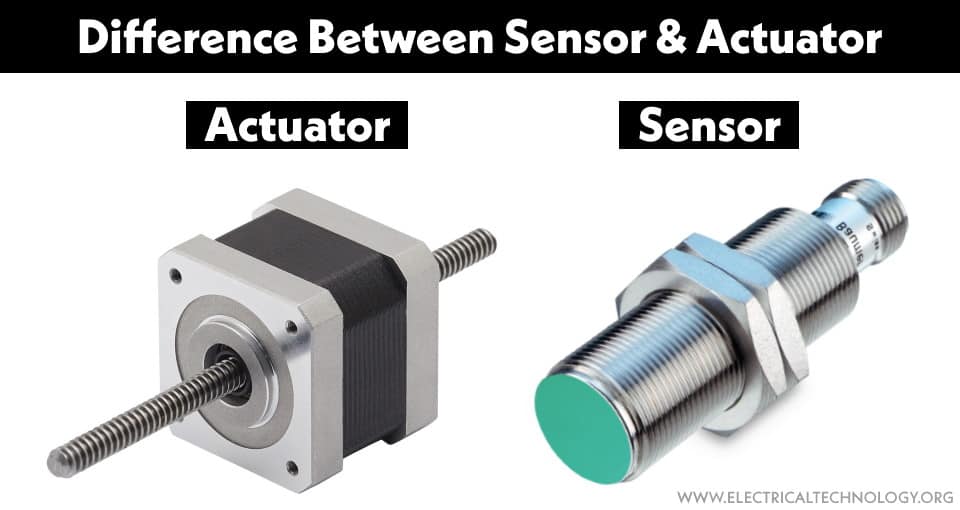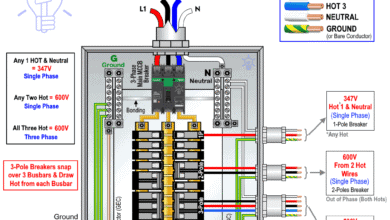Main Difference Between Sensor and Actuator
What is the Difference between Sensors and Actuators?
Sensor and actuator works in sync and relies on each other in an embedded system. They are used to automate an operation, make a system more reliable and eliminate the human error. The main difference is their function; the sensor is used to monitor and measure the changes in the environment and the actuator is used to control the environment.
Before going into the differences between sensor and actuator, let’s discuss their basics first.
- Related Post: Difference between Sensor and Transducer
Sensor
A sensor is a device that senses and measures any change in the physical environment. It converts the physical quantities into an electrical signal. It takes any input from the real world environment and feeds it into a system in the form of an electrical signal. It is connected at the input of a system and it supplies all the necessary data for processing.
There are different types of sensors available, A few examples of sensors are temperature, ultrasonic, pressure and position sensor, etc. As their name suggests, they are used for sensing and measuring the respective quantities.
A sensor works by sensing the quantity using a special sensing element. Each sensor has a different working principle such as electromagnetic sensor, capacitor sensor, resistive sensor, etc. Generally, they sense the corresponding attribute from the environment and convert it into an electrical signal of proportional magnitude.
A sensor can either be active or passive. A passive sensor does not require an extra power source to operate while a passive sensor requires an extra power source. A piezoelectric sensor is an active sensor that converts pressure into an electrical signal. An example of a passive sensor is a potentiometer whose resistance changes with the position but in order to convert it into an electrical signal, it requires extra power source.
Features of Sensor
- A sensor is a device used for monitoring and measuring the change in environment.
- It converts physical quantities into electrical signal.
- Its output is an electrical signal.
- It is connected at the input of a system.
- A sensor may be active and passive. Active sensor does not require power source while passive sensor do to operate.
- A sensor provides the necessary information to the system to understand the environment.
- Examples of sensors are light, heat, temperature, position sensor, etc.
Related Posts:
- What is a Sensor? Different Types of Sensors with Applications
- What is a Transducer? Types of Transducers and Applications
Actuator
An actuator is a device that converts electrical signal into mechanical work. It converts electrical energy into mechanical energy. It is used for generating movement or a change in environment. For example, a fan is used to reduce temperature. A servo motor is used for changing position etc.
Actuators are connected at the output of a system. It takes electrical signal as its input and generates mechanical movement as its output. It takes the input from a system or a signal conditioning unit (connected with a sensor) and provides output to the environment.
The actuator depends on the data provided by the sensor. The sensor provides the data to a signal condition unit or a system that processes the data and based on that data it sends command to the actuator. An example of such system is a “temperature control system”, where a temperature sensor monitors the temperature. If the temperature exceeds a certain limit, the system sends command to fan (actuator) to increase its speed and reduce the temperature. Another example is automatic door that opens when it senses a person.
There are five different types of actuators:
Manual Actuator: Such type of actuator is manually controlled using gears, levers and wheels, etc. They do not require a power source as they require human action.
Electric Actuator: Such actuators require electricity to operate. It uses an electrical motor to generate movement. They are fast and efficient.
Hydraulic Actuator: Hydraulic actuators use compressed fluid in a cylinder to generate pressure that facilitates mechanical movement.
Pneumatic Actuator: Pneumatic actuators use gas pressure to generate movement.
Spring Actuator: Such actuators have a loaded spring that is triggered and released to generate mechanical work. It can be triggered using several methods.
Features of Actuator
- The actuator is a device that converts electrical signal into mechanical movement.
- It takes an electrical signal as its input.
- Its output is mechanical work.
- It is connected at the output of a system.
- Actuator helps in controlling the environment according to the readings of the sensor.
- It requires extra power source to actuate.
- Examples of actuators are servo motor, stepper motor etc.
Related Posts:
- LVDT: Linear Variable Differential Transformer and Inductive Sensors
- Capacitive Sensor and Transducer and Its Applications
Differences between Sensor and Actuator
| Sensor | Actuator |
| It is a device that senses and measures changes in physical quantities. | It is a device that converts an electrical signal into mechanical movement. |
| Its input is a physical quantity. | Its input is an electrical signal. |
| Its output is an electrical signal. | Its output is mechanical work. |
| It takes input from the environment. | It takes input from the system or signal conditioning unit. |
| It provides output to a system. | It provides output to the environment. |
| It is connected at the input of a system. | It is connected at the output of a system. |
| A sensor may or may not require extra power source to operate. | Actuator require extra power source to operate. |
Related Posts:
- What is Piezoelectric Sensor? Construction, Working and Applications
- Types of Resistive Sensors and Transducer, Potentiometer and Strain Gauge
Comparison between Sensor and Actuator
Definition
- Sensor is a device that senses and measures any change or a physical quantity from its surrounding.
- Actuator is a device that converts an electrical signal into mechanical work.
Function
- Sensor is used for measuring physical quantity and converts them into a readable electrical signal so that the system can process it
- Actuator is used to generate mechanical movement.
Connection
- Sensor is connected at the input of a system.
- Actuator is connected to the output of a system.
Input
- The input of sensor is a physical quantity from an environment.
- The input of an actuator is an electrical signal.
Output
- The output of a sensor is an electrical system.
- The output of an actuator is movement.
Conclusion
Sensor and actuator both are used to perform a single task. The sensor monitors a real-world physical quantity and provides the necessary reading to a system. The system then processes the data and provides a command to the actuator in the form of an electrical signal. The actuator generates movement that creates the necessary change in the physical quantity.
Related Posts:
- Difference Between Thermistor and Thermocouple
- PIR – Infrared Motion Detector Circuit Diagram, Working and Applications
- Automatic Plant Watering and Irrigation System – Circuit, Code and Project Report
- Automated Fingerprint Identification System and How it Works?
- Infrared Motion Detector Circuit – Diagram, Working and Applications
- Rain Alarm Sensor– Snow, Water and Rain Detector Project
- Simple Touch Sensitive Switch Circuit using 555 Timer and BC547 Transistor
- Automatic Bathroom Light Switch Circuit Diagram and Operation
- Internet of Things (IoT) and Its Applications in Electrical Power Industry
- What is a Thermistor? Types of Thermistors and Applications
- Thermocouple – Types, Construction, Working and Applications









